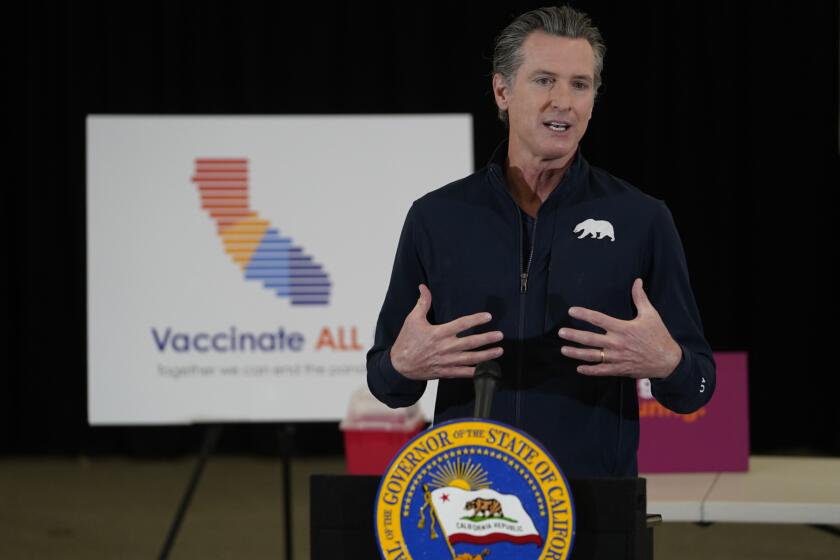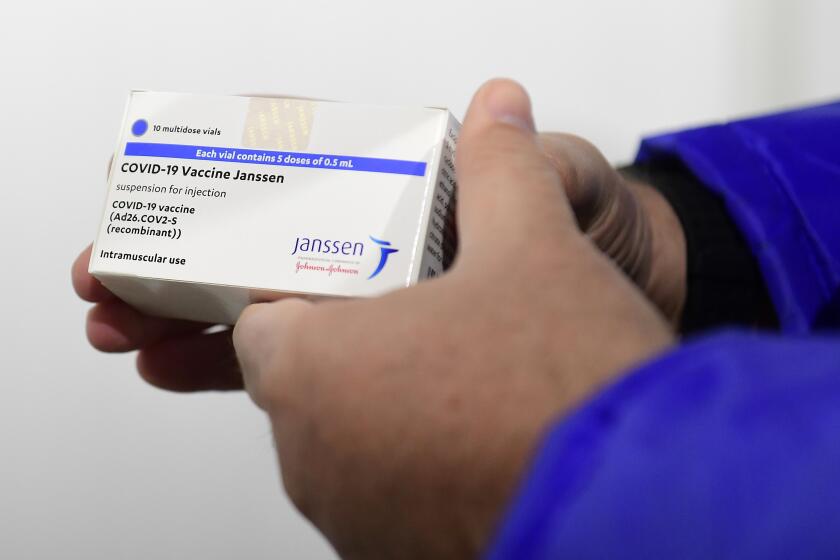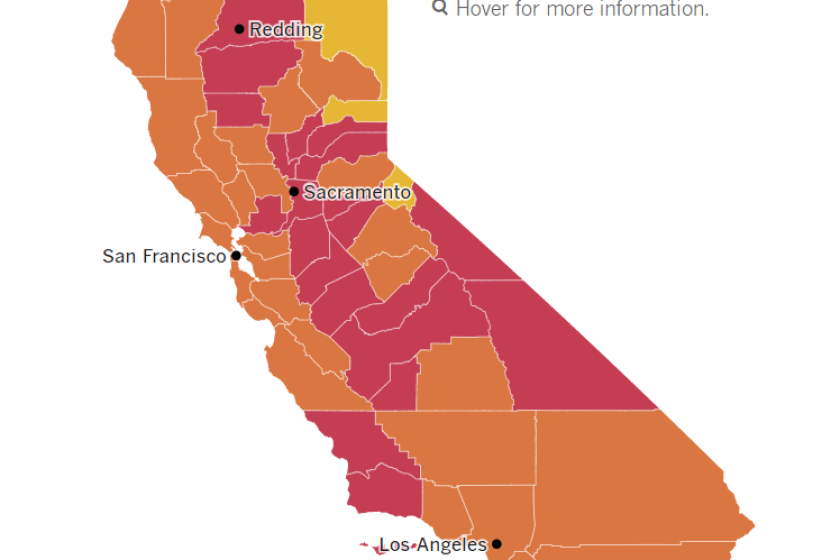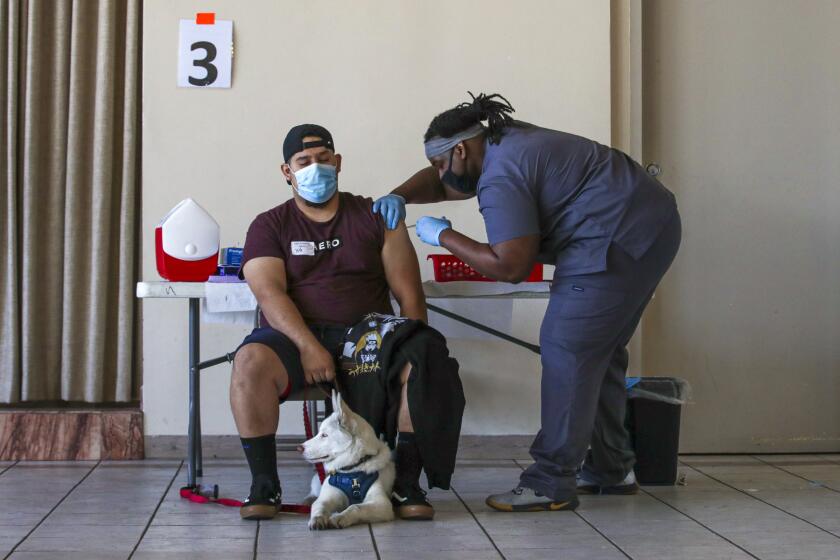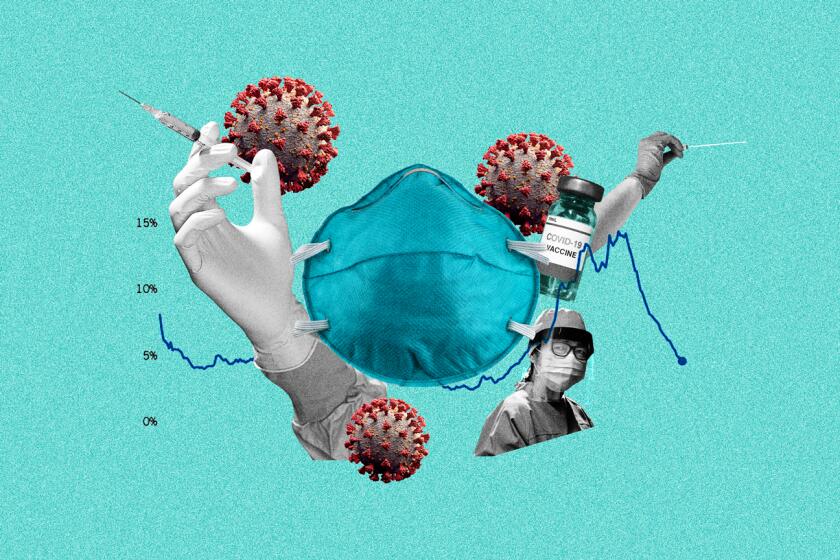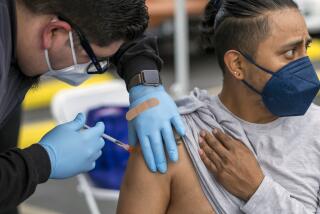Half of eligible Californians at least partially vaccinated, state says
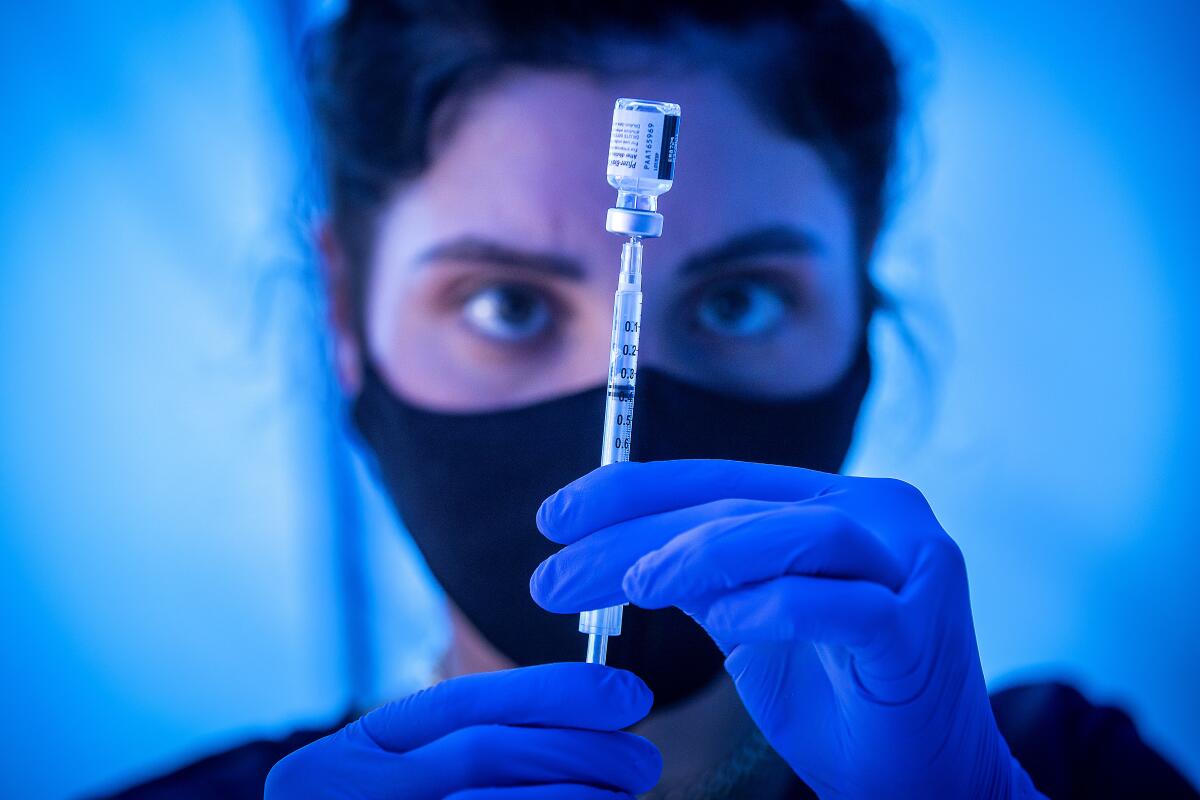
- Share via
More than half of California adults have now received at least one COVID-19 vaccine dose, a promising milestone that comes as the state is now inoculating as wide a swath of its residents as possible.
To date, 52.2% of Californians 18 and older have been at least partially vaccinated, according to the latest data from the Centers for Disease Control and Prevention.
That level of coverage ranks 11th among all states, federal figures show, and is higher than the proportion of adults who have received a dose in other heavily populated states — including Pennsylvania, 51.8%; New York, 51.3%; Texas, 45%; and Florida, 44.8%.
Nationwide, 48.3% of adult Americans have received at least one shot.
California removes the last barrier to widespread adult access to COVID-19 vaccines, though getting an appointment may still take some patience.
Overall, state health officials said Friday that 50% of Californians age 16 and older — all of whom are now eligible to book vaccine appointments — have received at least one dose.
“This historic milestone is a wonderful sign that Californians understand COVID-19 vaccinations are safe and effective and that our entire state is committed to getting to immunity,” Dr. Tomás Aragón, state public health officer and California Department of Public Health director, said in a statement. “Vaccinations are our best tool to ending the COVID-19 pandemic, and we will continue to ensure that every Californian who is old enough to get the vaccine has access to one.”
Gov. Gavin Newsom had previewed clearing that hurdle Thursday, but said reaching 50%, while promising, is “not good enough.”
“We are making progress. We’re going to defeat this disease. We’re going to end this pandemic,” he said during a news conference. “There’s a bright light at the end of the tunnel, but we still have more work to do.”
A major item on the state’s to-do list is ensuring that those who have been partially vaccinated for COVID-19 complete their inoculation regimen.
The two vaccines being most widely administered both nationwide and in California, from Pfizer-BioNTech and Moderna, each require two doses, given weeks apart.
As a result, while more than half of California adults have received at least one dose, only 29.2% are fully vaccinated.
That percentage trails the nationwide figure, 30.3%, and ranks 36th among states.
This, despite the fact that California has administered far and away the most vaccine doses of any state.
To date, 24.2 million doses have been doled out statewide. No other state has even reached 16 million, CDC data show.
But given that California is also the most populous state by far, it takes a steady firehose of doses to make a serious dent.
A third COVID-19 vaccine, from Johnson & Johnson, entails only a single shot, but California — acting on the recommendation of federal health agencies — has momentarily halted use of that brand as officials investigate six serious blood clot cases nationwide.
California officials have said they don’t expect the stoppage to be a major roadblock, at least in the near term.
But a one-two punch of unwelcome news on the J&J front — nationwide supply of the now-paused vaccine has also plummeted of late because of recent production issues — means California will have fewer doses to work with.
Why might some COVID-19 vaccines pose a small risk of blood clots while others don’t? Scientists suspect it’s related to their use of adenoviruses.
And, as the data demonstrate, having a readily available and usable supply of the one-shot Johnson & Johnson vaccine would undoubtedly accelerate the state’s vaccination effort.
Newsom, though, said California expects increasing supplies of Pfizer and Moderna will help cover the difference.
“The challenge is manufactured supply, and so the issue will resolve itself as more Moderna and more Pfizer make their way into the state and throughout the United States,” Newsom said. “But that’s foundationally been the constraint and been the challenge in the state of California.”
He also noted that the state’s direct federal allocation, expected to be about 1.9 million total doses next week, is not the only source of vaccine. Up to 1.5 million more doses are expected to be delivered to other vaccination sites supported directly by the federal government, such as qualified health clinics and pharmacies.
Los Angeles County, for instance, is set to directly receive 361,750 doses next week — but the total supply coming the region’s way, when accounting for these other streams, is expected to exceed 600,000, according to Dr. Paul Simon, chief science officer for the L.A. County Department of Public Health.
Simon said Friday that more than 700 vaccination sites are available across the county, “a very robust network that we hope will be able to handle this surge in volume in demand for vaccine.”
That’s particularly important now as all Californians 16 and over became eligible to be vaccinated as of Thursday.
In L.A. County alone, there are about 3.5 million people in the newly eligible 16 to 49 age range that have yet to receive a dose, Simon said.
While it may be challenging to snare an appointment, and residents should be patient in the face of possible delays, Simon said everyone should feel comfortable and encouraged to roll up their sleeves when their time comes.
“Many people may believe that they’ve weathered the pandemic so far unscathed and they’re healthy and, even if they become infected, they may not get ill,” he said during a briefing. “But vaccination is not only critically important for your own protection but it serves to protect others — your loved ones, your friends, anybody that you may interact with.”
Officials moved the lone remaining occupant of the category, Merced County, into the less-stringent red tier after reexamining the region’s data.
Widespread vaccination represents the surest, and quickest, way out of the COVID-19 pandemic, officials and experts say.
But with new cases on the rise nationwide, federal health officials remain concerned about the trajectory of the pandemic.
As of Wednesday, the country’s seven-day average of daily new coronavirus cases was 69,577 — up 31% from a month ago, federal figures show.
“The increasing trends in cases, hospitalizations and deaths are very concerning, and they threaten the progress we’ve already made,” CDC Director Dr. Rochelle Walensky said during a briefing Friday.
One factor fueling the recent rise, she said, is “relaxed prevention efforts in states across the country, such as relaxed mask mandates or loosened restrictions on indoor restaurant seating.”
“Another reason for these increases is the continued spread of highly transmissible variants ... which makes the race to stop the transmission even more challenging, and threatens to overwhelm our healthcare system again in parts of this country,” she said.
Among communities with at least 5,000 residents, those that saw the largest relative increases in their vaccination rates over a weeks-long stretch ending Monday were lower-income areas with predominantly non-white populations.
California has also recently seen an increase in reported new coronavirus cases.
Over the last week, the state has reported an average of 3,069 cases per day, a 21.1% increase from two weeks ago, according to data compiled by The Times.
In spite of that, CDC data show that California’s latest seven-day new case rate — 52.7 per 100,000 people per day — is the fourth-lowest among all states and significantly below the nationwide rate of 146.7.
By comparison, the highest rates have been recorded in Michigan, with 551.6 per 100,000 people; Rhode Island, 304.5; New Jersey, 287.2; Pennsylvania, 261.6; and Minnesota, 256.1.
Among larger states, the comparable rates over the same time period were 204.9 in Florida and 73.3 in Texas.
While any increase in cases is worth monitoring, California’s other coronavirus metrics continue to show promising signs of progress.
Though it’s oscillated a bit recently, the number of coronavirus-positive Californians hospitalized — 1,833 on Thursday — has fallen to a level not seen since last spring.
Are vaccines safe? When can I get a booster dose? Do I have to wear a mask? We’ve answered hundreds of newsletter readers’ questions. Here’s an archive.
Still, officials say residents need to continue taking steps to keep themselves, their families and their neighbors safe until more people can be vaccinated.
“What worries me is that we see very significant surges occurring in other parts of the country,” Simon said.
The coronavirus, he continued, “in no way respects borders; it travels person to person and, as people travel, there are more opportunities for the virus to spread to different jurisdictions.”
“That’s why, even though our numbers look pretty good right now, we’re really urging people to hang in for another couple of months in doing everything possible to prevent spread,” he said, adding that wearing face coverings in public, maintaining physical distancing and avoiding crowds remain key.
As Newsom emphasized, “This disease is not taking the month off or the summer off. This disease has not gone away.”
“Let’s not let down our guard. Let’s not take these masks off,” he said. “We still have work to do. The biggest mistake in this country that’s being perpetuated are people that are just giving up, not requiring these face coverings and just assuming that the mission somehow is accomplished. It’s not. This disease will come roaring back.”
More to Read
Sign up for Essential California
The most important California stories and recommendations in your inbox every morning.
You may occasionally receive promotional content from the Los Angeles Times.
